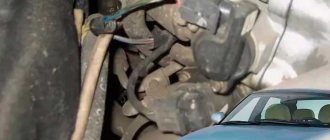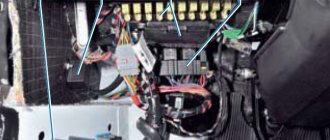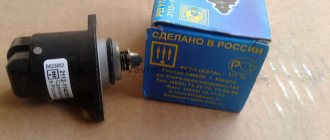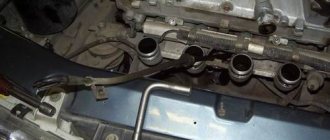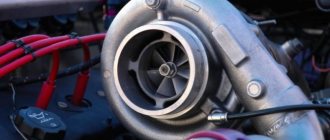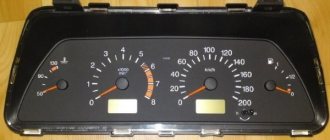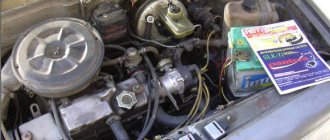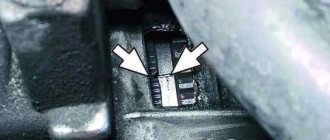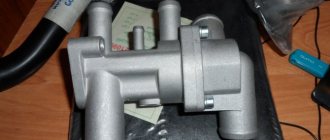Why the speed fluctuates - localization of the fault
First, you need to cut off potential sources of the problem close to the carburetor.
- Let's leave the fuel supply alone. It (gasoline) is either there and the engine is running, or it is not there and there is no problem with idling (as well as the engine itself);
- A potential culprit is a clogged engine air filter. The main cause of uneven idle is air, or rather oxygen, so we inspect the first obstacle in the way of oxygen especially carefully. If you changed the filter at the end of spring, it may be clogged with June poplar fluff. Regular trips on primers, or clouds of dust donated by the “coaters”, coke the pores of the filter element within a month. It happens that a low-quality product from “homemade” ones from the Middle Kingdom simply breaks into shreds and clogs the carburetor throttle assembly with scraps. In any case, let's start by checking the filter;
- The diametrically opposite reason is excess oxygen. The intake tract of an internal combustion engine is relatively sealed. All incoming air flows are carefully calculated by engineers. In injection systems there is a mass air flow sensor, and the ECU can adjust the mixture parameters depending on the oxygen flow. The carburetor has only a mechanical setting for a certain volume. Any unauthorized air leak causes floating speed. The filter breaks, the valve cover gasket breaks, or the carburetor seal leaks - and unaccounted for (and also dirty) air goes into the chamber. The leak can be on the fittings of the vacuum tubes and on the crankcase ventilation system.
A less common cause is the housing or diaphragm of the distributor vacuum regulator. That is, the device responsible for the stable operation of the power unit is itself the cause of the malfunction.
If none of the listed reasons are found, we will inspect the carburetor. Moreover, no special equipment, much less electronic devices, is required.
Jerks when cold
Many owners of the VAZ 2110 note that jerks occur when cold, and after warming up, the car gets into a rhythm while driving and stops “sausaging”. The main reason in this case is called a lean mixture, due to the fact that air is sucked in at idle. Or one of the sensors “died”.
If dips often occur when cold (as well as when driving), in addition to everything already listed, you need to check:
- spark plugs - if they have heavy carbon deposits, and even make poor contact with the wires, this needs to be corrected urgently. In the first case - by replacement, in the second, by cleaning and strengthening contacts;
- high voltage wires . Checked with an ohmmeter (multimeter). But if they even look old and shabby, it’s better to just replace them all at once;
- ignition coil . You need to check the armored wires and the ignition module while wearing rubber gloves, otherwise you may get a slight electric shock if there is a break;
- The timing belt can jump a couple of teeth, then when cold there may well be failures. Therefore, check whether the marks on the pulleys match. If not, the belt must be removed and set correctly;
- be sure to check the oxygen sensors (OS); mass air flow (MAF); idle air regulator (IAC), if a malfunction is detected, replace them;
- filters . In principle, they need to be checked first, even before serious damage occurs. Air and fuel filters are designed to give cars a clean mixture. That is, they take on all the debris particles, so they become clogged, worsening the dynamics of the car, and also increasing fuel consumption. They need to be changed regularly.
IF YOU HAVE CHECKED EVERYTHING, TRIED TO FIX IT, BUT NOTHING HELPS, YOU SHOULD ONLY SEEK THE REASON IN THE ENGINE ITSELF.
It is possible that the fuel injectors in a fuel-injected vehicle are clogged. Then you will need professional diagnostics in the service.
You should not miss one more point, because of which, when cold, as well as when driving, metamorphoses such as twitching can occur with the car: did you put the right gasoline in it? Advice to all car enthusiasts is always relevant: if possible, refuel at a reliable, proven gas station. Low-quality fuel can not only cause jerking, but also damage not only the fuel pump, but the entire engine.
If you find an error, please select a piece of text and press Ctrl+Enter.
Source
We are looking for the reason why the idle speed on the VAZ 2110 is floating
- The first thing I recommend paying attention to is the mass air flow sensor (MAF or flow meter). Read this article on how to check the mass air flow sensor.
- The second “suspect” usually becomes the idle air regulator (IAC), if after checking the flow meter you do not find anything, check the IAC.
- After this, inspect the wiring of the speed sensor (DS). Read how to check and replace the DS here.
- The next sensor that can cause floating idle speed is the crankshaft position sensor (CPS). The sensor itself is unlikely to have failed; most likely the reason is in the wiring or chip. If you don’t find anything strange in the wiring, check the DPKV.
- The throttle assembly can also often affect the idle speed, so it would be a good idea to check the TPS (throttle position sensor), as well as the throttle valve itself, it may need cleaning. How to clean the throttle valve I wrote here.
- Plugs, high-voltage wires and the ignition module can cause problems with idle, so first check the high-voltage wires, and then the spark plugs.
- Engine idle speed fluctuates often due to a faulty idle speed solenoid valve. To test this valve, remove power from it, then turn on the ignition and connect the power wire to the contact on the valve. In this case, you should hear a distinct click; if this does not happen, connect the wire to the contact that is connected to the “positive” terminal of the battery. Even if you do not hear a click, you can conclude that the valve is faulty. If there is a click, but the engine speed fluctuates as before, check its jet.
Among other things, check the condition of the air filter; it may need to be replaced. Make sure that the ignition system is working properly and that there are no air leaks.
If the tips and recommendations described above do not produce results or you are not sure that you can cope with such work, seek help from professionals; specialists will quickly and accurately determine the source of the malfunction and stabilize the floating idle speed of the engine.
Thank you for your attention, I will be glad if it helps someone. If you know other reasons or methods of verification, you can safely add to this article using the comment form. Until we meet again, take care of yourself and your car.
Source: vaz-remont.ru
Signs of breakdown
Based on certain signs, it can be determined that the IAC is out of order and needs to be repaired or completely replaced with a new device.
These signs include:
- Floating idle speed;
- Problems with starting the engine; it starts with difficulty even with the gas pedal pressed;
- It is not possible to increase the speed even when the engine has warmed up sufficiently;
- The engine suddenly begins to stall when shifting into neutral;
- The speed decreases when you turn on energy-consuming devices - stove, air conditioner, audio system, headlights, etc.
But replacing the regulator is not always the right decision. In some cases, removing the old sensor and installing a new device in its place will not bring any results. And all because the culprits of the malfunction may be other elements, such as spark plugs or a fuel filter.
Functionality check
If the engine stalls, the speed fluctuates, or turns out to be high, you must definitely check whether the IAC is working.
To check, you will first need to dismantle the fastenings of the throttle assembly, and then carefully move it literally 10 millimeters.
You will need a voltmeter with which you can check whether there is voltage going to the sensor and what its indicators are. In advance, connect the negative terminal from the battery to ground, and connect the voltmeter to the terminals marked with the letters A and D. Next, check the table.
| Indications | What do they mean |
| The voltmeter shows less than 12V | This means that the battery is most likely dead. |
| There is no data on the meter | The problem should be looked for in the wiring circuit or in the electronic engine control unit |
| Voltmeter shows 12V or more | Be sure to check the idle air control resistance. There are problems with him. The tester is connected to 4 pins. Normal resistance readings are 50 or 55 ohms |
Additionally, do a pairwise check. In this case, the resistance should be infinitely large. If the XX sensor shows different numbers, then the regulator requires mandatory and immediate replacement.
Article on the topic: Which is the best body kit to choose for a VAZ 2114
There is another way to check the functionality of the device. To do this, you need to remove the sensor and connect the block. Press the needle with your finger and watch it extend. When the ignition is turned off, the needle should push.
If there is no shock, you can still try to solve the problem by simply cleaning the device. Use a universal and all-powerful product called WD40. Wet the entire mechanism thoroughly with it and, armed with cotton swabs, clean everything you can reach. When cleaning, pay special attention to the needle and stem.
If these measures do not help, there is nothing else left but to replace the IAC.
Procedure: from simple to complex
The simplest solution is to sell the car. Maybe this is the best decision. When your car has a high mileage and service life, and you are not a professional auto mechanic, then there is no point in undertaking repairs. If you are not very strapped for money, if numerous “unreasonable” breakdowns occur, perhaps the best solution is to exchange the VAZ 2109 for a simple used foreign car or a new Lada.
But if you decide to tinker with your Samara and adjust the idle speed yourself, start with simple things. Inspect the electrical wiring, inspect the contacts, touch the connector pads. The causes of floating faults often lie in the vehicle's electrical wiring. It gets hot and dry - there is contact, gets wet and cools - there is no contact.
If, when moving the wires under the hood, a malfunction appears and disappears, start ringing the wires one by one. Particularly vulnerable in the “nines” is the harness that leads to the fuse box. It is located next to the drain coming from the windshield, and during precipitation it gets wet more intensely than others.
Among other simple things that can cause the 9's engine speed to fluctuate at idle is a clogged air filter. This applies to both carburetor and injection versions of the power plant. It's easy to check.
Remove the air filter from the preheated engine, leaving the carburetor inlet pipe freely open. Start the engine. If the speed stabilizes, change the air filter. If not, install the filter back and move on to further research.
Useful video
You can glean additional interesting information from the video below:
Published September 21, 2019
The five-door hatchback VAZ 2114 is a restyled model of the famous “nine”, which rolled off the assembly line of the car plant from 2003 to 2013. At various times, the manufacturer installed on the car power plants with carburetor or distributed fuel injection (injector) of its own making, and since 2007 the car has been equipped with an electronic engine control system. Note that all these engines have one common and very significant drawback - when they switch to idle mode, their crankshaft speed suddenly begins to “float”.
Idle speed control
With no less probability, another malfunction is possible - IAC. The lack of reaction from the computer speaks in his favor. The operation of this node is actually carried out “the old fashioned way”, without the participation of a computer. This is a small electric motor, like a motor for children's cars with a damper, which automatically shuts off the fuel supply to the idle system in power mode.
Its malfunctions are usually associated with the fact that the motor stops working or the damper becomes clogged, as a result of which the idle channel does not close. Thus, the machine seems to simultaneously operate in two modes, each of which interferes with the other.
The procedure for checking the IAC is also in the corresponding material on our website, you can refer to it. What is the solution: replace the IAC or simply clean it with carb cleaner.
Methodology for finding problems on domestic carburetor systems
Before you start troubleshooting, you need to check that the carburetor is adjusted correctly. The manufacturer sets the settings for ideal operating conditions - the amount of oxygen in the atmosphere of flat terrain and gasoline that complies with GOST. And this is on a new car.
In reality, periodic adjustment of all 4-5 carburetor adjustment screws is required. At least two of them are responsible for stable idle operation. The adjustment is made with the engine running using a simple screwdriver.
The procedure is described in the owner's manual, and differs slightly depending on the carburetor model. The main condition for correct tuning is the absence of leaks, a clean air filter, and high-quality gasoline. The amount of oxygen in the air corresponds to daily use. That is, if you live on a plain, there is no point in adjusting the carburetor while climbing a mountain serpentine to an altitude of 800 meters above sea level.
- Warm up the engine to a temperature of 90°C. If there is no thermometer, the degree of heating can be easily determined by the opening of the cooling system thermostat;
- We start the engine, give a small load - turn on the headlights and the climate system (without air conditioning). Each type of carburetor has its own idle speed, let’s take 750-800 rpm as a basis, as on Solex. The idle speed is controlled by the “quantity” and “quality” screws of the mixture. It will not be possible to establish normal speed with wine alone;
- The forced choke lever (choke) is closed;
- Using the “quality” screw, we adjust the speed to the maximum possible value. As a rule, the screw is fixed at the factory and closed with a plug. It needs to be removed;
- Next, using a standard (on the dashboard) or remote tachometer, set the speed to 900, turning only the “quantity” screw;
- Then use the “quality” screw to set the required value: 750-800 rpm.
Afterwards, you need to start the engine in normal mode, make a test drive, and accelerate in neutral several times to the maximum speed. Then turn off the engine, and after a couple of minutes start it again and check the number of revolutions at idle with a load (high beam + heater). If necessary, repeat the adjustment process.
Causes of uneven engine idling
Experts divide the main reasons for rough idling into two categories:
- problems with fuel or fuel system;
- problems with electrical and electronic controls;
A malfunction of the air system (intake) can be considered separately, but it is more appropriate to include it in the list of problems with the fuel system. The fact is that both of them are inextricably linked and affect the stability of the power unit in idle mode and under load.
- Fuel-air system and fuel. A poor fuel-air mixture is often the reason why the engine idles rough. Such a “poor” mixture is that there is too little fuel in it and too much air.
Excess air can be sucked in through damage in the line. For example, rubber fuel hoses of poor quality may initially have or acquire microcracks in their walls over time. Poor fixation of the hose also contributes to air leaks at the joints.
A more serious problem can be considered a problem with the idle air valve (also known as the idle air regulator, the secondary air regulator), which is sometimes called the idle air sensor. Owners of carburetor cars also know this part as the “solenoid valve.”
Excess air can also be sucked in through, for example, broken holes in the throttle valve axis on the carburetor. In this case, the problem may not become noticeable immediately: gasoline consumption will gradually increase, and interruptions in idling will appear.
- Poor quality fuel. Because of it, the idle speed also often “floats”. This phenomenon is especially strong when using so-called eco-gasoline. It contains a certain amount of ethanol. Ideally, this not only makes the exhaust gases less toxic, but also helps clean the fuel system.
However, in practice, drivers either deal with counterfeit fuel, manufactured in violation of technology, or use such fuel incorrectly. The fact is that for normal engine operation of the specified “eco” type gasoline in the tank there should be no more than 40-50 percent.
- The fuel pressure regulator (aka low pressure bypass valve) has failed. Its task is to maintain the required fuel pressure while the engine is running in any mode.
This breakdown is indicated not only by uneven engine operation at idle, but also by interruptions if you sharply press the gas pedal, a drop in power, and a strong increase in fuel consumption.
- The injectors are clogged (the channels are coked). Due to poor operation of the injectors, the fuel mixture is of inadequate quality in composition, which leads to disruptions in the operation of the power unit in different modes and increased fuel consumption.
- Air damper malfunction. This is usually a mechanical interference, which also leads to the formation of a poor-quality fuel-air mixture. As already mentioned, this causes the engine to run unevenly.
- The idle speed on the carburetor is not adjusted. In this case, under load the engine will operate normally, but at idle it will sometimes jerk, and at the same time there may even be a slight popping sound in the muffler. A relatively simple problem that you can deal with yourself by tightening the required adjusting screw.
At idle the speed of the VAZ 2109 carburetor floats
The reasons for the floating speed of the VAZ 2109 carburetor engine are varied. All of them are directly related to problems with the carburetor, electrical system, working power units or the engine itself. The root of the problem is that the idle speed of the VAZ 2109 carburetor fluctuates; there are problems associated with interruptions in the supply of fuel to the engine or with the cessation of functioning of the ignition system mechanisms.
Device role
On injection engines that are installed on the VAZ 2110, the XX regulator serves to control the stable operation of the power unit. It is unlikely that you will be pleasantly surprised by a situation in which the idle speed starts to fluctuate, and every now and then the car will stall.
Some people do not know about another very important role of the idle speed sensor - warming up the power unit in case of low air temperature.
It is generally accepted that if there is an injector, there is no need to warm up the engine. The opinion is wrong. Do not overstress the engine, but first let it run for a while without increased speed. This will have a positive effect on the reliability and service life of the motor. .
Location
Externally, the IAC looks quite simple. It looks like a small electric motor. Its design includes three parts:
- Stepper motor;
- Spring;
- A rod with a needle at the end.
And the desired regulator is located near the mechanism that is responsible for changing the position of the throttle valve. There is no complex fastening system. To dismantle you just need to remove the mounting bolts.
How does he work
The function of the IAC is to regulate the amount of fuel supplied. He may indicate the need to increase or decrease the quantity. An important nuance is that the sensor performs its functions directly when the idle speed is turned on.
The actual action of increasing or decreasing occurs due to the extension or retraction of the needle at the end of the rod. The needle is responsible for closing or opening the special channel to the required extent.
Learning to distinguish a fake from an original
Today, many people complain about the abundance of counterfeit products on the auto parts market.
If we talk specifically about the XX regulator for the VAZ 2110, then there are several key signs by which a fake can be distinguished from the original. Be guided by these data so as not to accidentally install a device of dubious quality and origin on your car.
Fake and original
- On fakes, the black body made of metal is 1 millimeter shorter than the real part.
- In the case of the fake, the three white rivets on the case have no heads. They must be present in the original. And the diameter of the caps is 3 millimeters.
- On fakes, the spring is made in white and has more frequent winding. In the original, the coiling is less frequent, and the spring itself is black.
- Pay attention to the rubber ring of the regulator. On fakes it is black and thin, but in the case of a real part, a reddish tint is noticeable. Plus the thickness is greater.
- Take a closer look at the tip. In fakes it is darker compared to the original spare part.
- There are no markings on the counterfeit packaging; the boxes are noticeably different in appearance.
- The original yellow sticker located on the case must have an outer frame. Manufacturers of counterfeits apparently forgot about it.
Article on the topic: Independent replacement of the steering rack and its anthers on a VAZ 2114
As you can see, recognizing a fake is not difficult. You just need to be more attentive to details.
The difference is in the boxes
Electrical system
A failure on the part of the electrical system is indicated by:
- increased fuel consumption;
- difficult starting of the engine and its unstable operation;
- tripling.
It should not be ruled out that your VAZ is faulty:
- power wiring;
- contacts in the generator;
- spark plug.
Start your inspection with the candles. The presence of soot, excessive clearance, or partial cable breakage on them increases the resistance. Failure of insulation also leads to voltage leakage. Therefore, the wires are inspected closely, paying attention to the wiring of the terminals and the contacts of the latter.
Is the EGR system on the injector working?
"Floating" speed can be caused by jamming of the exhaust gas recirculation (EGR) valve, which is installed in the exhaust manifold. It is necessary to periodically remove dirt from the valve seat and its seat using a carburetor cleaning aerosol, avoiding liquid getting on the sensor diaphragm.
The valve seat must be kept clean.
Attention! If cleaning the unit does not give a positive result, the device must be replaced.
The VAZ engine does not work properly - why is repair needed?
Over time, almost every owner of a VAZ 2109 is faced with a problem such as a drop in engine speed at idle. Why can't I use a faulty machine? In this condition, operating the vehicle is problematic. At a traffic light, the car, when the speed drops, may suddenly stall or when the gear is engaged in neutral.
If such a situation arises, the VAZ driver must constantly support the car by pressing the gas pedal. This operation is performed so that the vehicle does not stall when the speed jumps at idle on the VAZ 2109 in the carburetor. When such a difficulty arises, the driver notices that the tachometer needle constantly symbolizes the presence of different revolutions. This figure ranges from 500-1200. The car is shaking, which additionally causes discomfort.
If you find that the idle speed of a VAZ 2109 in a Solex carburetor is floating, then you should not put off solving the problem. Due to such unstable functioning of the carburetor, other vehicle systems may also fail. And this will lead to the need for more expensive repairs.
Testing the mass air flow sensor (MAF)
Let us remind you what we are talking about - VAZ-2110 8-valve injector: the speed drops and stalls. A reasonable question arises: what to do? If the reason is not the IAC, then it is worth testing the mass air flow sensor. Here are some recommendations on how to do this:
- Disconnect the sensor connector from the on-board system. The controller that controls the engine will operate in emergency mode, but for short testing this is not fatal. If your car runs much faster, then the problem is most likely in the mass air flow sensor. It's time to clean it.
- Replace the sensor with a working one, and then see how the engine works. There are improvements, which means you need to either clean or replace your own mass air flow sensor.
- It also makes sense to inspect the air intake; to do this, you need to remove the mounting clamp and carefully inspect the inside of the air intake, there should be no condensation or oil there. If any are found, then it will have to be cleaned with special means.
- You can also test the mass air flow sensor using a multimeter. To do this, you need to switch the multimeter to voltmeter mode and set it to 2. The sensor has 2 wires - yellow and green. Yellow transmits a signal to the controller, and green transmits a signal to ground. When the ignition is turned on, we take measurements between these two wires. The engine should not be running. If the readings are in the range of 1.01-1.02, then the sensor is in perfect order. Readings in the range of 1.02-1.03 – it’s time to clean the sensor. And if the indicators go off scale to 1.04, then it’s time to get a new sensor.
We recommend: Cooling system ZMZ-406: operating principle of engine cooling on Gazelle and Volga - “InfoSort”
Signs of malfunctions
It should be noted that it is difficult to successfully resolve this situation without making the correct “diagnosis”. It is important to check all working components of the motor.
The following symptoms indicate poor carburetor performance:
- The Lada engine speed drops on its own, resulting in an unreasonable increase.
- There are gaps in the functioning of the cylinders.
- In the area of the carburetor and muffler, sharp pops periodically occur.
- At idle, the number of rotations is unstable, they have fallen.
The reasons for the drop in rotation at idle solex appear due to violations of the operating conditions of the vehicle. The manufacturer determines the rules for using the vehicle. Often, problems with the carburetor (idles float) are a consequence of unfavorable climate conditions (high humidity levels, high temperatures, changes). Do not forget to check the engine's performance in a timely manner.
Source: prokarbyrator.ru
Possible reasons
So, what causes this problem? Some of the most vulnerable links in injection engines are sensors. One of the elements that directly affects engine performance and quality is the idle speed sensor. You can often find it near the throttle valve. This is a stepper motor with a tapered locking needle. When the throttle is closed, air bypasses the damper through the idle channel, which is blocked by the needle.
Another culprit for very low idle speed is the MAF (mass air flow sensor). Air is the second important component for preparing the fuel mixture after gasoline. Therefore, if the mixture is lean enough, then high speeds will not come from anywhere.
When malfunctions occur in the system, the ECU cannot correctly select and calculate the proportions of the fuel mixture in idle mode. As a result, the engine operation will be unstable, the speed will begin to fall and rise.
A less common problem with low idle speeds on a warm engine can be improper operation of the EGR system, or more precisely its valve. The element is installed in the intake manifold and its function is to remove exhaust gases. This is nothing more than a crankcase gas valve. The sensor must be cleaned periodically.
The idle speed of the VAZ 2110 is floating, diagnostics and replacement of the IAC
Many people underestimate the importance of sensors or idle air control. But in fact, the speed stability depends on the correct operation of the IAC. It also prevents the car from stalling when the gearshift lever is in an intermediate position.
In this material we will talk about the meaning, device, and signs of malfunction of this device. We’ll also tell you how you can easily replace the IAC with your own hands.
Appearance of the device
